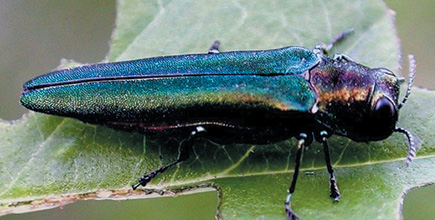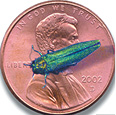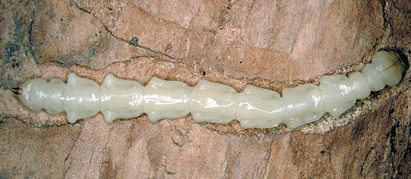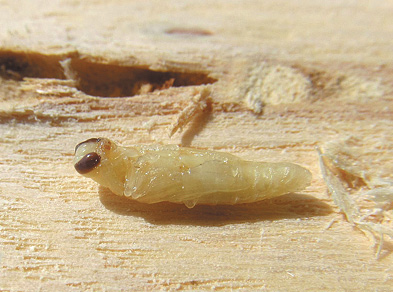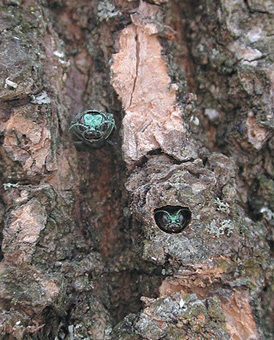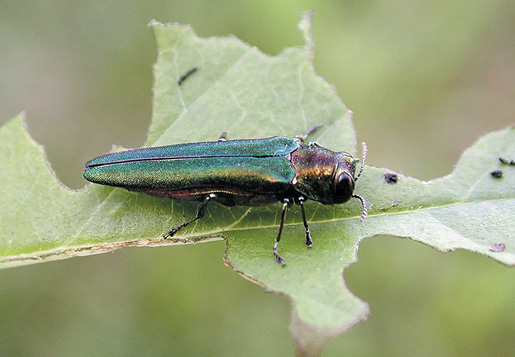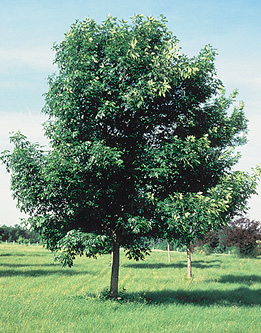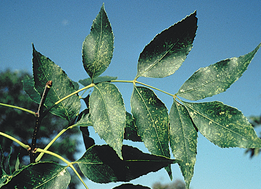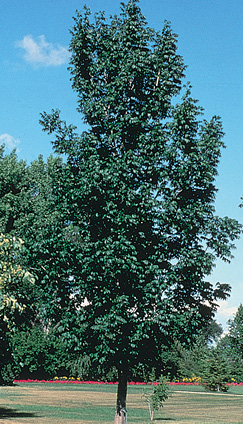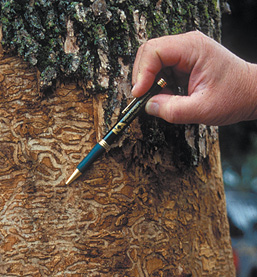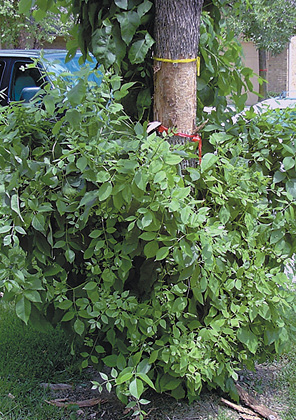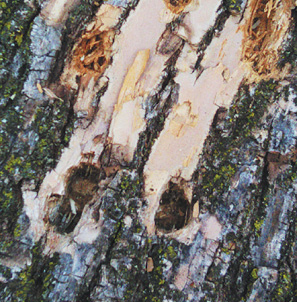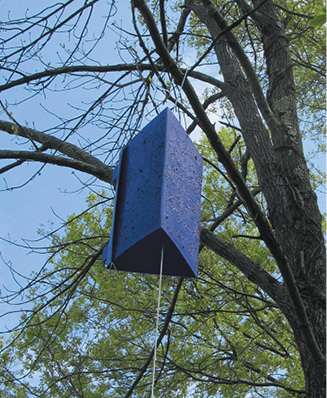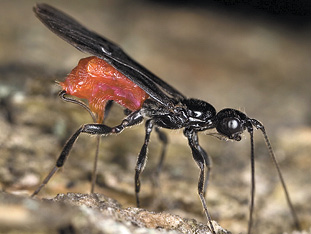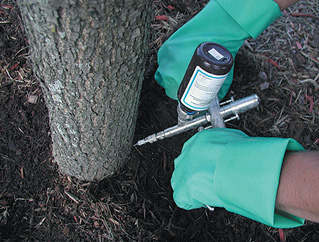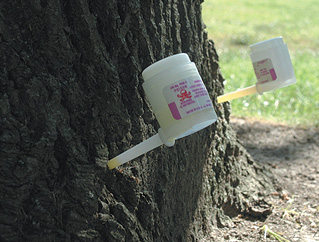Adults are recognized as metallic, wood-boring beetles (Family Buprestidae) by their short saw-toothed antennae, blunt head and elongate yet compact body with metallic coloration.
The adult EAB is distinguished from other North Dakota Buprestidae by its size (about ½ inch or 13 millimeters [mm]), overall metallic green with coppery reflections on the pronotum (shieldlike body segment behind the head), and the bright metallic red of the upper surface of the abdomen (Figures 2 and 3).
Figure 2. Size of emerald ash borer adult compared with a penny

Figure 3. Emerald ash borer adult (D. Cappaert, Bugwood.org)
The elytra (hard front wing covers) and membranous hind wings must be spread apart completely to view the dorsal surface of the abdomen. The abdomen projects beyond the elytra as a blunt-ended spine.
Eggs are oval to round, less than 0.039 of an inch (1 mm) in diameter, and although white when laid, they rapidly turn red-orange (Figure 4). Because eggs are laid in bark crevices, they are not readily observed.
Figure 4. Emerald ash borer egg
Larvae create characteristic serpentine tunnels beneath the bark of their host ash trees (Figure 5). Tunnels curve at near right angles so that the tunnel length, as measured in a straight line from start to end point, is less than half of the actual total tunnel distance through the wood.
Figure 5. Serpentine tunnel created by emerald ash borer larva
EAB larvae (Figure 6) are recognized by their enlarged and flattened pronotum, elongate body shape with abdominal segments one to seven trapezoidal, abdominal segment eight bell-shaped, and the last abdominal segment round with two spines (urogomphi, Figure 7).
Figure 6. Emerald ash borer larva
Figure 7. Comparison of prepupa of emerald ash borer (left) and red-headed ash borer (right). Circle shows two spines (urogomphi) on emerald ash borer larva
Overwintering larvae excavate a deeper chamber at the end of their tunnel and take on a compact appearance, with body segments somewhat telescoped together. At this point, they are called prepupae. A comparison of common wood-boring ash insect larvae is provided in Table 1.
Table 1. Larvae of ash-boring insects in North Dakota: comparison with emerald ash borer.
|
Character
|
Emerald ash borer
|
Red-headed ash borer
|
Carpenterworm
|
Ash/lilac borer
|
Ash bark beetles
|
| |
Larva
|
Prepupa
|
Larva
|
Larva
|
Larva
|
Larva
|
|
Length
(late instar)
|
0.71 inch
(18 mm)
|
0.51 inch
(13 mm)
|
0.39 inch
(10 mm)
|
3 inches
(75 mm)
|
0.59 inch
(15 mm)
|
0.12 inch
(3 mm)
|
|
Shape
|
thin and wormlike
|
thick and wormlike
|
thick and wormlike
|
caterpillarlike
|
caterpillarlike
|
grublike
|
|
Thoracic legs
|
absent
|
absent
|
present
|
present
|
present
|
absent
|
|
Prolegs
|
absent
|
absent
|
absent
|
present
|
present
|
absent
|
|
Urogomphi
|
present
|
present
|
absent
|
absent
|
absent
|
absent
|
Pupae have the characteristic shape of the adult beetle, with short, serrate antennae and blunt spine at the tip of the last abdominal segment (Figure 8). Newly formed pupae are white.
Figure 8. Emerald ash borer pupa
As the beetle within develops, the pupa takes on the adult form. When the adult emerges, the pupal exuvia (shed skin) remains in the pupal chamber. By contrast, two other common ash-boring insects, ash/lilac borer (Podosesia syringae) and carpenterworm (Prionoxystus robiniae), have the pupal skin partially or mostly extruded from the adult exit hole. Buprestids of the genus Agrilus, such as EAB, leave D-shaped emergence holes (Figure 9).
Figure 9. D-shaped emergence hole of emerald ash borer
